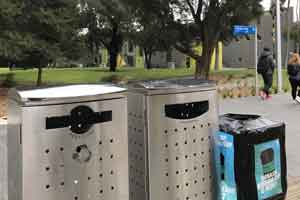Extending Sustainability to Your Workplace
If you are an SGA reader your garden is probably quite sustainable, but what about your workplace? Whether you work in a large corporate organization, a small startup or run your business from the comfort of home, we can all do more to make our offices greener. And considering that we spend around a fifth of our lives at work, the cumulative effects of greener office habits are too substantial to ignore. Luckily, a number of initiatives exist to green up office spaces and processes, such as the Green Impact program, a newcomer to the Australian sustainability landscape specifically designed for tertiary education institutions.
Universities are natural testing grounds for fresh sustainability initiatives, especially given the focus of today's youth on combating climate change. As the news headlines continue to show, young Australians are extremely worried about the environment and are taking action in droves. In one recent survey, 95% of young Aussies cited climate change as their number one concern.
It should come as no surprise then that Green Impact has its roots in student activism. The program was developed by the U.K.'s National Union of Students, and came to Australia after receiving the UNESCO-Japan Prize for Education on Sustainable Development. Now in its second year at Monash University (where I work), the program engages teams of students and staff university-wide to spark grassroots action via a series of tasks and challenges – no small feat on a campus of over 41,000 students (and growing) plus thousands of staff. That's a lot of energy used, paper printed and disposable coffee cups thrown away! It also provides a significant opportunity for large-scale impact.
I serve as a team leader and together we have learned a lot about how to make incremental changes. While Green Impact is tailored to universities, the challenges are applicable to most offices. Here are a few of the most useful tips I've come across so far:
 Printed meeting agendas: These are easy to avoid. Use your phone or laptop to view documents and save paper, ink and energy, or request that the presenter utilise conference room technology to display the agenda.
Printed meeting agendas: These are easy to avoid. Use your phone or laptop to view documents and save paper, ink and energy, or request that the presenter utilise conference room technology to display the agenda.- Reusable kitchenware: Does your communal kitchen have only a few lonely forks that never seem to be in the drawer when you need one? Buying a stack of plates, bowls and cutlery is an easy, low-cost way to avoid disposables, encourage healthy eating and facilitate zero-waste social events.
- Food waste: See if your workplace has a compost bin or is willing to invest in one for those banana peels, tea bags and sad desk lunch leftovers you just couldn’t finish (we’ve all been there). Alternatively, take your food scraps home to your garden compost bin or worm farm.
- Collaboration is key: It's easy to feel discouraged about the effect of individual actions, but assembling a small group of like-minded colleagues really can start a trend toward sustainability. Bringing together perspectives from different departments is crucial in ensuring that you cultivate a wide range of suggestions as well as a sense of ownership throughout the team.
If you're interested in developing a more sustainable workplace I encourage you to team up, start with small changes and find creative solutions for your unique workplace challenges. In this age of climate despair, my team and I have found it incredibly energizing to organize and work toward a greener and healthier workplace, one process at a time. In the words of teenage environmental activist Greta Thunberg, "If solutions within the system are so impossible to find, maybe we should change the system itself."

